
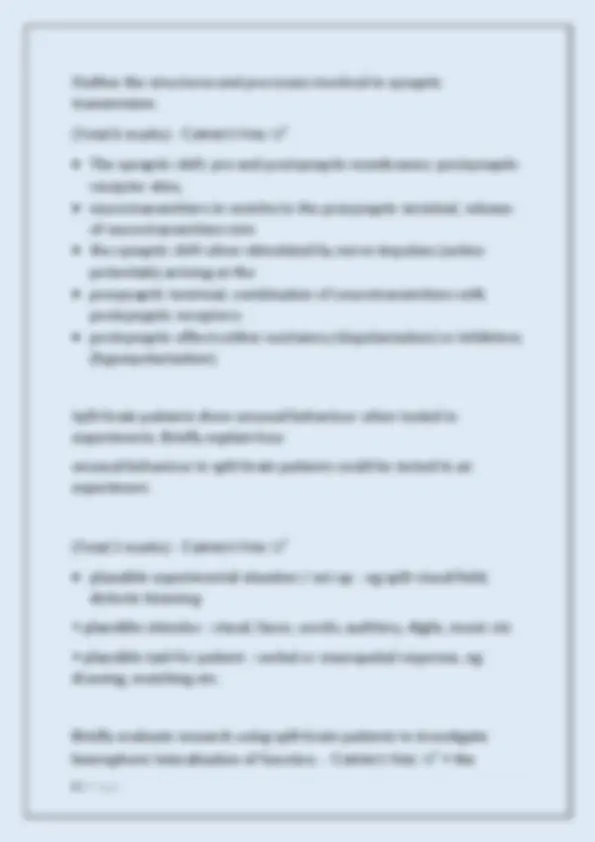
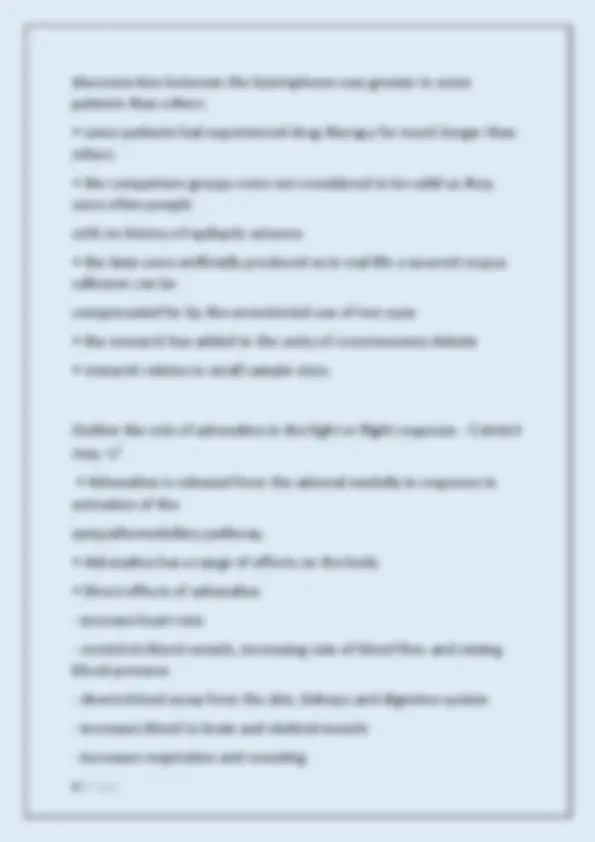
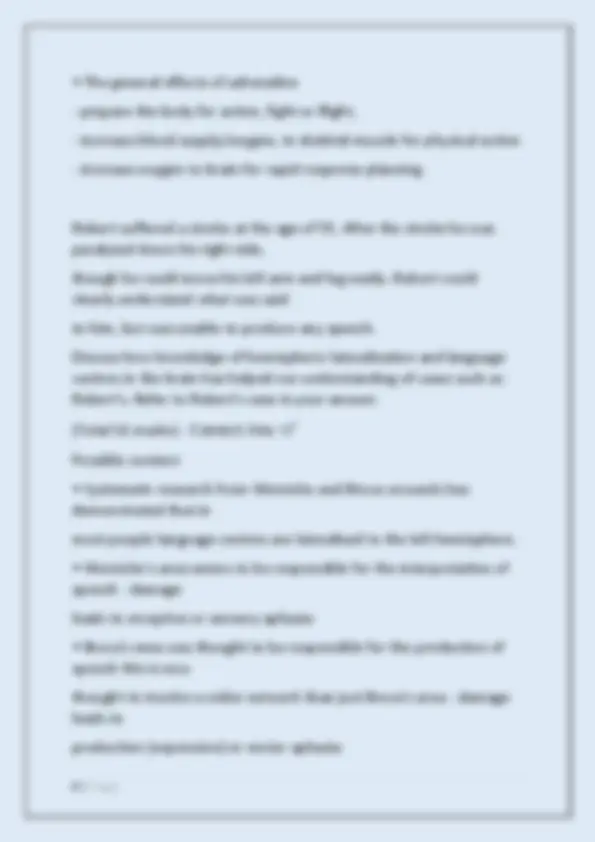
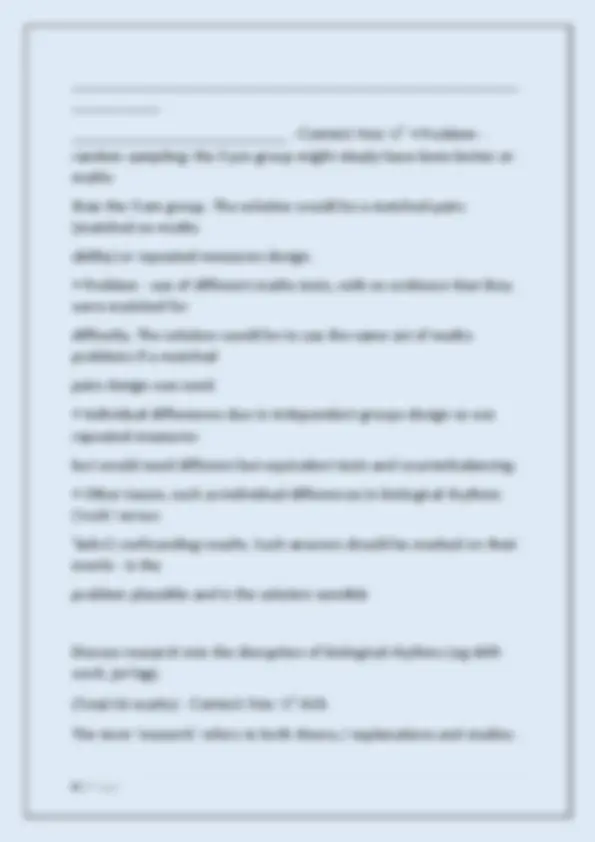
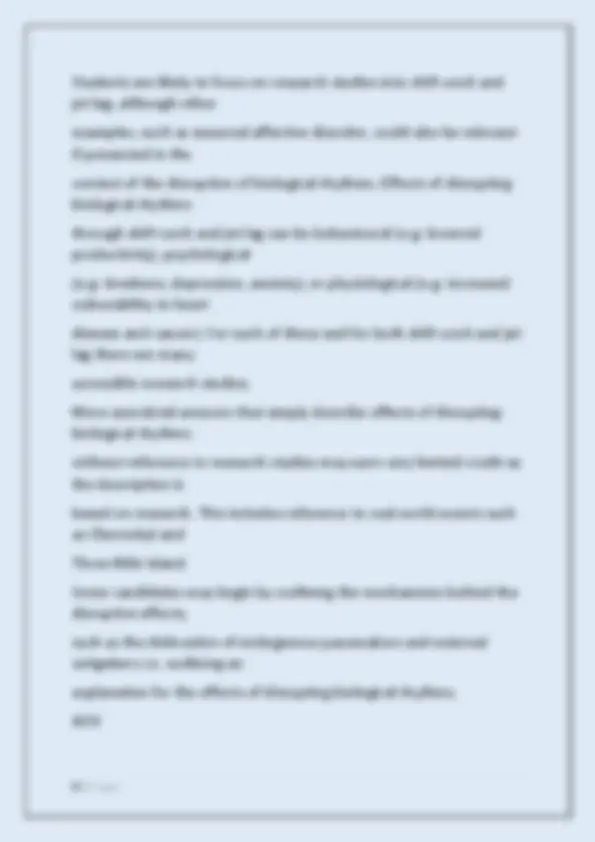
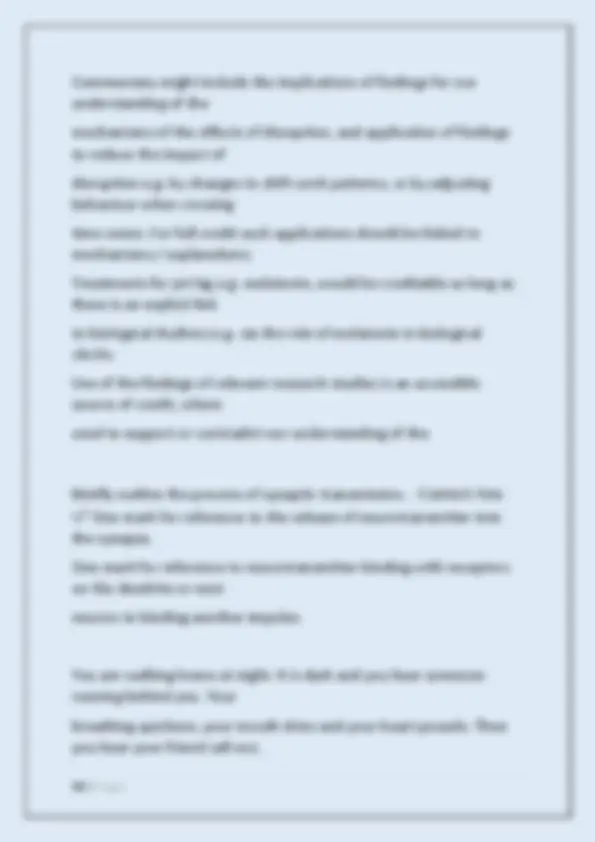
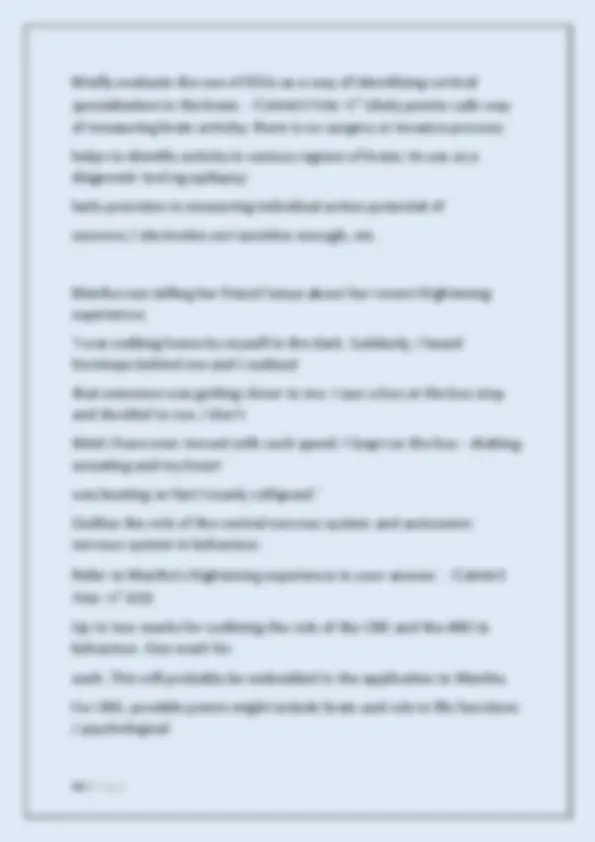
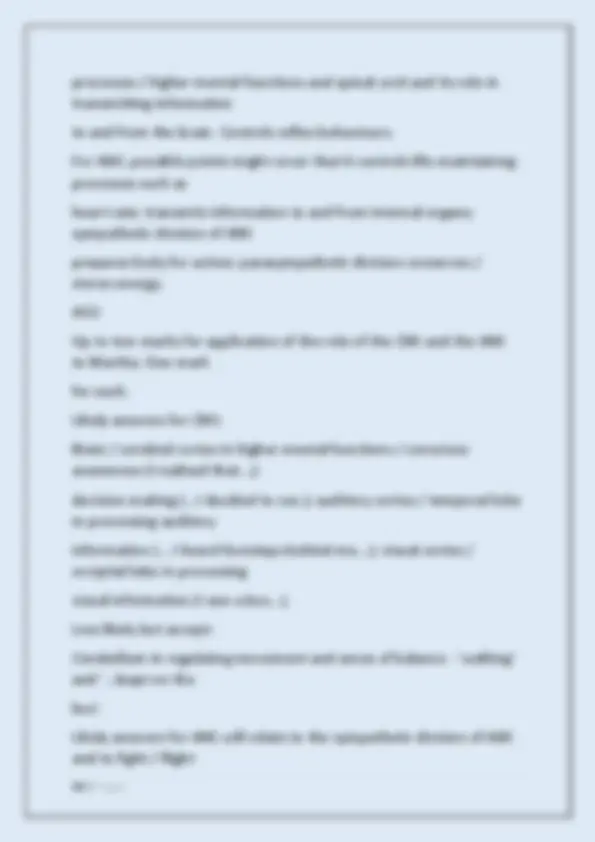
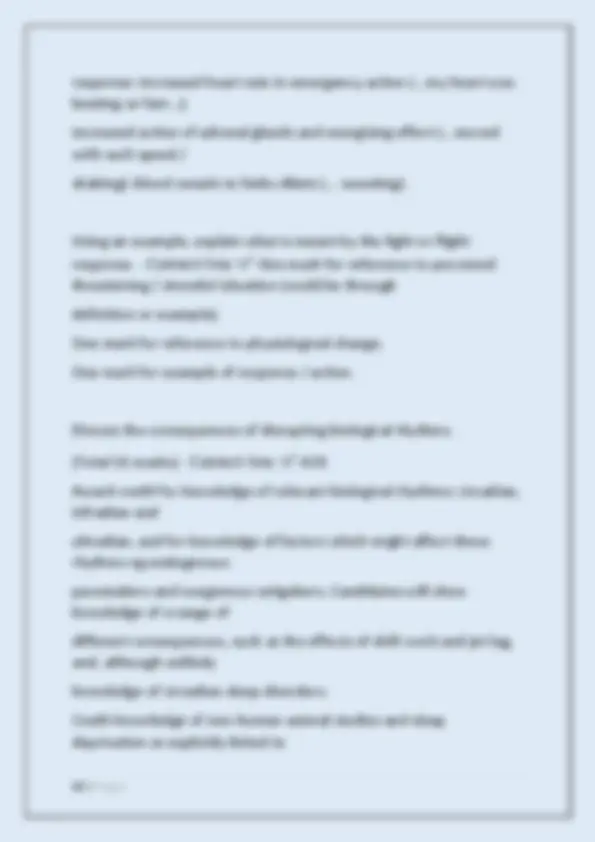
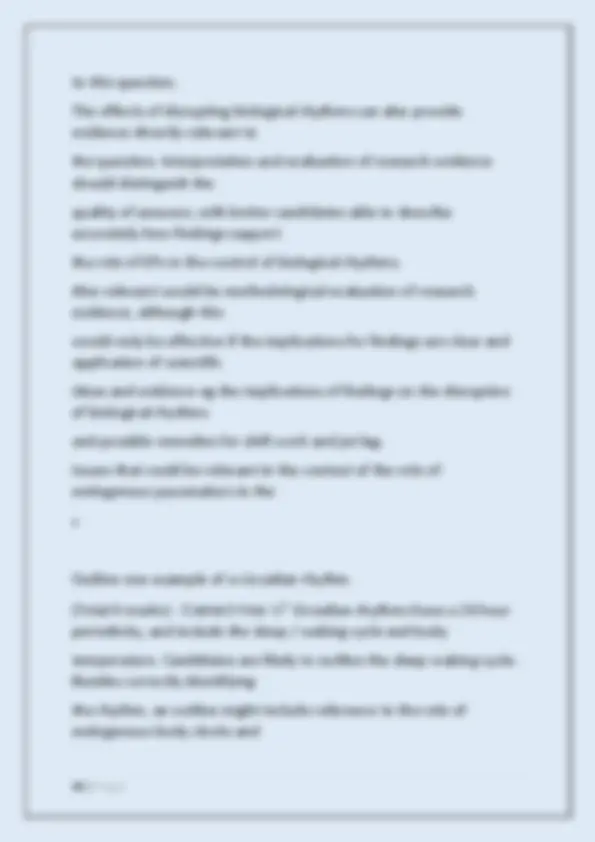



Study with the several resources on Docsity

Earn points by helping other students or get them with a premium plan


Prepare for your exams
Study with the several resources on Docsity

Earn points to download
Earn points by helping other students or get them with a premium plan
Community
Ask the community for help and clear up your study doubts
Discover the best universities in your country according to Docsity users
Free resources
Download our free guides on studying techniques, anxiety management strategies, and thesis advice from Docsity tutors
A series of questions and answers related to biopsychology, covering topics such as synaptic transmission, the endocrine system, the electroencephalogram (eeg), event-related potentials (erps), hemispheric lateralisation, and biological rhythms. It provides insights into the functioning of the brain and its role in various physiological and psychological processes. Useful for students studying biopsychology or related fields.
Typology: Exams
1 / 19

This page cannot be seen from the preview
Don't miss anything!












Briefly outline how excitation and inhibition are involved in synaptic
transmission (4) - Correct Ans: ✅
inhibitory).
impulse.
impulse.
neuron is inhibitory, the neuron will be less likely to 'fire' and if the net effect is excitatory,
the neuron will be more likely to fire.
Briefly explain one function of the endocrine system (2) - Correct
Ans: ✅
The electroencephalogram (EEG) and event-related potentials (ERPs) both involve recording the
electrical activity of the brain.
Outline one difference between the EEG and ERPs - Correct Ans: ✅
EG is a recording of general brain activity
usually linked to states such as sleep and arousal, whilst ERPs are elicited by specific
stimuli presented to the participant.
Sam is a police officer. She has just started working the night shift and after a week, she finds that she has difficulty sleeping during the day and is becoming
tense and irritable. Sam is also worried that she is less alert during the night shift itself.
Using your knowledge of endogenous pacemakers and exogenous
zeitgebers, explain Sam's experiences. - Correct Ans: ✅
endogenous pacemakers - internal biological rhythms
now out of synchrony with the zeitgeber of light
increased anxiety and decreased alertness and vigilance.
disconnection between the hemispheres was greater in some patients than others
with no history of epileptic seizures
compensated for by the unrestricted use of two eyes
Outline the role of adrenaline in the fight or flight response - Correct
Ans: ✅
sympathomedullary pathway.
Robert suffered a stroke at the age of 55. After the stroke he was paralysed down his right side,
though he could move his left arm and leg easily. Robert could clearly understand what was said
to him, but was unable to produce any speech.
Discuss how knowledge of hemispheric lateralisation and language centres in the brain has helped our understanding of cases such as Robert's. Refer to Robert's case in your answer.
(Total 16 marks) - Correct Ans: ✅
Possible content
most people language centres are lateralised to the left hemisphere.
leads to receptive or sensory aphasia
thought to involve a wider network than just Broca's area - damage leads to
production (expressive) or motor aphasia
understand or to produce speech), combined with right sided paralysis.
A psychologist wanted to test the effects of biological rhythms on the ability to solve maths
problems. She used random sampling to form two groups each of 20 students.
She tested one group on one set of maths problems at 3 am in the morning. The other group
were tested on another set of maths problems at 3 pm in the afternoon. She found that
performance of the group tested at 3 pm was significantly better than the group tested at 3 am.
When submitted for peer review the paper was rejected because of serious design problems.
18
Explain one problem with the design of this study and suggest ways of dealing with this problem.
___________________________ - Correct Ans: ✅ • Problem - random sampling; the 3 pm group might simply have been better at maths
than the 3 am group. The solution would be a matched pairs (matched on maths
ability) or repeated measures design.
difficulty. The solution would be to use the same set of maths problems if a matched
pairs design was used.
but would need different but equivalent tests and counterbalancing.
'larks') confounding results. Such answers should be marked on their merits - is the
problem plausible and is the solution sensible
Discuss research into the disruption of biological rhythms (eg shift work, jet lag).
(Total 16 marks) - Correct Ans: ✅ AO
The term 'research' refers to both theory / explanations and studies.
Commentary might include the implications of findings for our understanding of the
mechanisms of the effects of disruption, and application of findings to reduce the impact of
disruption e.g. by changes to shift work patterns, or by adjusting behaviour when crossing
time zones. For full credit such applications should be linked to mechanisms / explanations.
Treatments for jet lag e.g. melatonin, would be creditable as long as there is an explicit link
to biological rhythms e.g. via the role of melatonin in biological clocks.
Use of the findings of relevant research studies is an accessible source of credit, where
used to support or contradict our understanding of the
Briefly outline the process of synaptic transmission. - Correct Ans:
✅ One mark for reference to the release of neurotransmitter into the synapse.
One mark for reference to neurotransmitter binding with receptors on the dendrite or next
neuron to binding another impulse.
You are walking home at night. It is dark and you hear someone running behind you. Your
breathing quickens, your mouth dries and your heart pounds. Then you hear your friend call out,
"Hey, wait for me! We can walk back together." Your breathing slows down and after a couple of
minutes you are walking home calmly with your friend.
Explain the actions of the autonomic nervous system. Refer to the description above in your
answer. - Correct Ans: ✅ Up to 2 marks for description of the actions of the autonomic nervous system.
Likely points: one section of the autonomic nervous system (sympathetic nervous system)
responds to a perceived threat / it produces physiological changes that prepare the body
for fight or flight (the alarm response) (1), and the other section (parasympathetic nervous
system) restores normal physiological functioning when the threat has passed (1).
If candidates simply state flight or flight and rest and digest with no further explanation 1
mark only.
AO
Up to 2 marks for application to the description. One mark for application to sympathetic
activity - breathing quickens, mouth dries, heart pounds. One mark for application to
parasympathetic - breathing slows down / becoming calm.
Maximum of 2 marks if 'sympathetic' and 'parasympathetic' sections are mislabelled in
AO1 description
Briefly evaluate the use of EEGs as a way of identifying cortical
specialisation in the brain. - Correct Ans: ✅ Likely points: safe way of measuring brain activity; there is no surgery or invasive process;
helps to identify activity in various regions of brain; its use as a diagnostic tool eg epilepsy;
lacks precision in measuring individual action potential of
neurons / electrodes not sensitive enough, etc.
Martha was telling her friend Sanya about her recent frightening experience.
'I was walking home by myself in the dark. Suddenly, I heard footsteps behind me and I realised
that someone was getting closer to me. I saw a bus at the bus stop and decided to run. I don't
think I have ever moved with such speed. I leapt on the bus - shaking, sweating and my heart
was beating so fast I nearly collapsed.'
Outline the role of the central nervous system and autonomic nervous system in behaviour.
Refer to Martha's frightening experience in your answer. - Correct
Ans: ✅ AO
Up to two marks for outlining the role of the CNS and the ANS in behaviour. One mark for
each. This will probably be embedded in the application to Martha.
For CNS, possible points might include brain and role in life functions / psychological
processes / higher mental functions and spinal cord and its role in transmitting information
to and from the brain. Controls reflex behaviours.
For ANS, possible points might cover that it controls life-maintaining processes such as
heart rate; transmits information to and from internal organs; sympathetic division of ANS
prepares body for action; parasympathetic division conserves / stores energy.
AO
Up to two marks for application of the role of the CNS and the ANS to Martha. One mark
for each.
Likely answers for CNS:
Brain / cerebral cortex in higher mental functions / conscious awareness (I realised that...);
decision making (...I decided to run.); auditory cortex / temporal lobe in processing auditory
information (... I heard footsteps behind me...); visual cortex / occipital lobe in processing
visual information (I saw a bus...).
Less likely but accept:
Cerebellum in regulating movement and sense of balance - 'walking' and '...leapt on the
bus'.
Likely answers for ANS will relate to the sympathetic division of ANS and to fight / flight
the consequences of disrupting biological rhythms.
An effective route to discussion/evaluation marks would be methodological evaluation of
research and field studies as relevant to the consequences. A second route would be
commentary on the implications of findings eg what modifications to shift work have been
shown to alleviate its effects? Does our knowledge of the mechanisms behind jet lag
suggest possible ways of minimising its effects? Accurate explanations of why/how
disrupting biological rhythms has such effects ie the roles of endogenous pacemakers and
exogenous zeitgebers, would qualify as extended commentary.
Examiners should be sensitive to depth / breadth trade-offs in answers that cover several
consequences or examples of disruption.
Further relevant discussion points might broader approaches eg biological, general issues
related the research eg reductionism; ethical issues; applications of psychological research
eg to the alteration of shift work patterns.
Discuss the role of endogenous pacemakers in the control of one or more biological rhythms.
(Total 16 marks) - Correct Ans: ✅ AO
The emphasis in this question is in the 'role' of endogenous pacemakers. Endogenous
pacemakers (EP) and exogenous zeitgebers interact in the control and fine tuning of
biological rhythms. An effective approach to marks would be to describe examples of
endogenous pacemakers, such as the suprachiasmatic nucleus (SCN), pineal gland and
melatonin release. There are other pacemakers in the brain, eg for body temperature,
although answers focusing on the SCN and pineal may receive marks across the scale. A
further route to marks would be to describe the mechanisms underlying the interaction
between EPs and exogenous zeitgebers such as light.
AO
It is likely that research evidence will provide the major source of discussion on this
question. There are many studies supporting a role for EPs in the control of biological
rhythms, and how they interact with exogenous zeitgebers; these include Siffre's original
isolation study and subsequent similar work, experiments on infradian rhythms, and even
research on non-human animals (eg hamsters) and plants could be made directly relevant
external zeitgebers such as light. However any material relevant to the sleep-waking cycle would
be credit-worthy. This section should be marked bearing in mind time constraints.